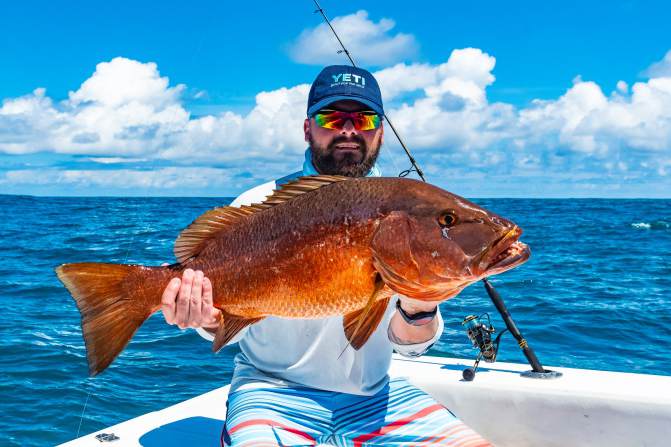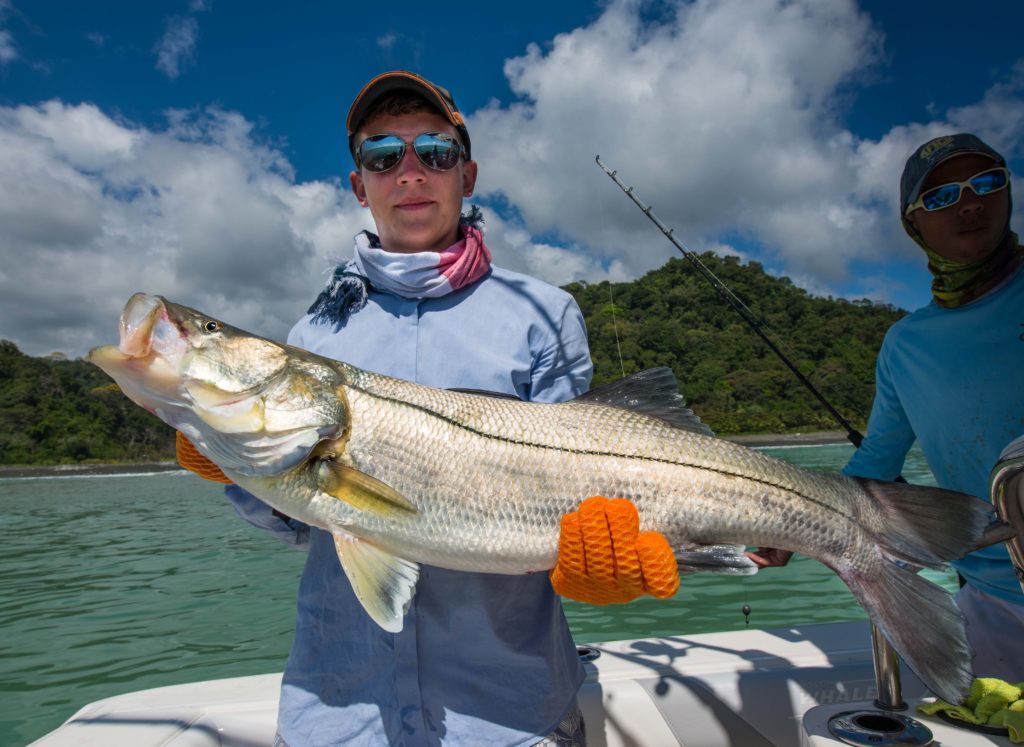inshore fishing
Take time out to enjoy some inshore fishing off the coast of the Osa Peninsula. Fishing the Gulfo Dulce can be an exciting and rewarding experience for many reasons. The gulf is known for its diverse and abundant marine life, which includes a variety of game fish such as snook, roosterfish, and the cubera snapper. These species are known for their strong fighting abilities and can provide a challenging and exhilarating fishing experience.
Golfo Dulce translated means “Sweet Gulf” and the name says it all! This gulf is known for its beautiful, unspoiled natural setting, with pristine rainforest, mangroves and diverse wildlife. Inshore fishing is excellent to good year round due to the bowl shape of the gulf and numerous rivers depositing fresh water and providing a healthy food-rich environment.
Another exciting aspect of fishing in the Gulfo Dulce is that it offers a wide range of fishing opportunities, from casting with lures or live baiting, to fly fishing or trolling. This means that anglers of all skill levels and preferences can find a fishing method that suits them.
When you fish with Crocodile Bay, you’ll get the best local guides who has extensive knowledge of the area, which can greatly enhance the fishing experience by helping to find the best spots, providing tips and techniques, and ensuring compliance with local regulations.

THE ROOSTERFISH
“Rise to the Challenge, Reel in the Rooster!”
King of inshore / near shore fishing, and very sporting on lighter tackle! The roosterfish is a hard-fighting and widely sought-after game fish here in Costa Rica. Luckily, Crocodile Bay is centrally located in the roosterfish’s range and they are abundant here year-round. Anglers from across the globe travel to Crocodile Bay in search of this prized species. Almost all of our guests have roosterfish at the top of their wish list. This fish can only be found in the Pacific, and they are found from southern California down to Peru. While they average 20 – 30 pounds, numerous trophy fish are landed at Crocodile Bay in the 50 – 60 pound range weekly. The current IGFA world record is 114 pounds. Are you ready to beat it?
Roosterfish are generally green or olive on their backs with four black bars evenly spaced along their bodies. Their iridescent skin is beautiful when reflected by the sunlight. Their most distinguishing feature is their iconic seven-stranded dorsal fin which reminds you of the rooster’s comb which is where this species gets its’ name. This “crest” of fins when extended, stands straight up similar to the top of a rooster’s head. It’s widely accepted that the roosterfish raise their crest to help corral bait (much like a sailfish uses its’ sail) and to make themselves appear larger when predators are nearby. Without a doubt, roosterfish live up to their reputation of being one of the most exciting, hard-fighting inshore fish available, and a main attraction to anglers.
These fish are catch and release.
CUBERA SNAPPER
"Hooked on the Hunt for Costa Rica Cubera Snapper"

“Like a huge fireball, a cubera snapper explodes on the surface and throws water in every direction. Line screams off the reel. Even the blister raised on the thumb, as extra pressure is applied to the drag…. is not enough. The snapper’s power is too much and it escapes into a rocky cavern below. The fisherman is left with the lasting memory of a runaway freight train on the end of his line.” – Todd Staley
and… some anglers have more of a story to tell.
This great fighter is the most popular of all the local snapper due to its size and sheer strength. Fish over 50 pounds have been caught in the area all year round. They have a distinctive red-orange color and a broad, slightly rounded body. They have a large mouth, with sharp teeth. They are found in a variety of habitats, mainly in the rocky reef in our area, typically in depths between 30-150 feet. Smaller ones are the best for consumption and the larger fish are generally released since they are female and breeding stock.
SNOOK
"snookin" for a thrill"

Snook (or Robalo, as known in Costa Rica) grows on average as large as 45 pounds. The IGFA world record for Snook is 53 pounds and 10 ounces. They are known for their sleek, elongated bodies and large mouths with sharp teeth. Snook are considered a prized game fish due to their strong fighting ability and are considered to be among the most welcomed bites in Costa Rica due to their delicious white meat.
This fish moves in and out of salt and fresh waters. With the amount of freshwater flowing into the gulf, it provides both surf and estuary fishing for this fish to be caught. Snook have a distinctive dark lateral line that runs along the length of their body, and their coloration can vary depending on the location, but are typically silver or gold on the sides, with a dark stripe running along their sides. On Costa Rica’s Pacific coast, anglers can catch snook all year round on poppers, jigs, rapalas, and with live bait such as sardines, blue runners and mullet.
Although available year-round, your chances of catching a snook are better during their peak in November and December. Reels for snook should have a capacity of 150 to 200 yards and a good drag system.
"Reel in Variety! Gulfo Dulce's inshore fishing Adventure"
In addition to snook, roosterfish, and cubera snapper, there are several other species of inshore fish that can be found in the in this area of Costa Rica. Some of the other species that are commonly caught include (but certainly not limited to):
Snapper: several species of snapper, such as yellowtail snapper, mutton snapper, and dog snapper, can be found in the Gulfo Dulce.
Grouper: species such as yellowfin grouper and black grouper can be found in the Gulfo Dulce.
Jack Crevalle: This species is common in the Gulfo Dulce, known for its powerful runs and acrobatic jumps when hooked.
Needlefish: This species is also found in the Gulfo Dulce, known for its long pointed snout, sharp teeth and its long slim body.
Shark: Several species of shark can be found in the Gulfo Dulce, including the bull shark, which is known for its aggressive behavior and strength.
Barracuda: These fish are common in the Gulfo Dulce and are known for their long, cylindrical body, sharp teeth, and speed.
Pompano: This species is common in the Gulfo Dulce and is known for its delicate white meat and sweet flavor.

